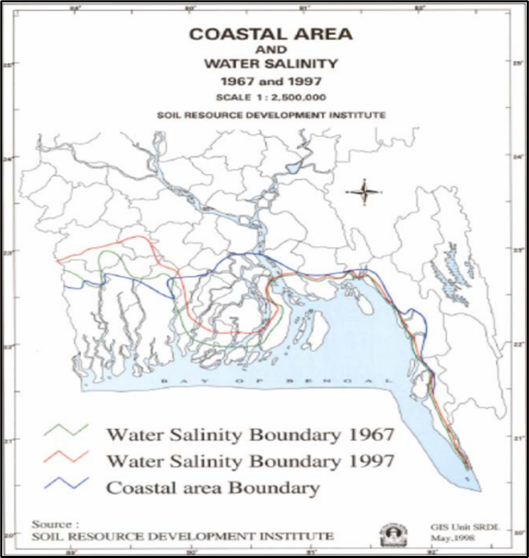Mains Daily Question
April 28, 2023
Elaborate upon the impact of the rising sea level on the coastal regions of India. Also, mention the measures taken by the Government of India to mitigate the repercussions of this sea-level rise.
Approach:
Introduction: Briefly mention the reasons for rising sea levels with some data showing the rise.
Body: Mention the implications of rising sea levels on coastal regions of India. Also, mention the government initiatives in this regard.
Conclusion: Conclude with a positive way forward to combat the overall menace of climate change.
Answer:
Rising sea levels are a global phenomenon that is caused by various factors such as climate change, melting of polar ice caps, and thermal expansion of ocean water. The possibility of sea level rise in the next ten years is about 3.2 cm in the north Indian Ocean if the sea level acceleration remains similar to 3.2 mm per year. The coastal regions of India, which are home to millions of people, are particularly vulnerable to the effects of this phenomenon.
The overall impact of rising sea levels on the coastal regions in India can be multidimensional and multi-faceted like,
Socio-Economic Impact:
- Climate-change-induced displacement: Coastal erosion due to rising sea levels has led to the displacement of thousands of people living in low-lying areas along the coast. According to the United Nations Refugee Agency (UNHCR), Nearly 50 lakh people in India were internally displaced due to climate change and disasters in 2021.
- Impact on Fisheries Sector: This displacement has resulted in the loss of livelihoods for fishermen and other coastal communities, who are heavily dependent on the sea for their sustenance. This would lead to an overall downturn in the Marine and fisheries sector.
- Coastal tourism, which is a major contributor to the economy of many coastal states, has also been adversely affected due to beach erosion and flooding caused by rising sea levels.
- Economic loss: The destruction of infrastructure and property due to flooding and erosion has resulted in significant economic losses for the affected communities.
- Impact on Agriculture: Increased saltwater intrusion into groundwater reserves has impacted agriculture, leading to lower yields and increased irrigation costs.
- Could widen existing socio-economic disparities: The impact of rising sea levels on coastal areas can also exacerbate existing socio-economic disparities, as poorer communities are often more vulnerable to the effects of climate change.
Environmental Impact:
- Impact on Coastal Ecosystem: Rising Sea levels have resulted in the loss of important coastal ecosystems, including mangroves and coral reefs, which serve as breeding grounds for marine life and help protect coastal communities from storms and floods. For example - Hazardous living conditions were caused by unusually high tides post the Indian Ocean tsunami in 2004 When water displaces natives from the "sinking island" of Kerala.
- Impact on Habitat: Increased flooding and erosion have also led to the destruction of habitats for several endangered species of flora and fauna. The loss of coastal ecosystems can have a cascading effect on marine biodiversity, which in turn can have significant implications for fisheries and other industries dependent on the sea.
- Impact on freshwater ecosystems: The melting of glaciers due to rising temperatures is also contributing to rising sea levels, which could have a significant impact on freshwater ecosystems, particularly in the Ganges-Brahmaputra delta.
- Loss of freshwater habitat: Increased salinity in groundwater can also lead to the loss of important freshwater habitats, which can impact terrestrial ecosystems as well.
Measures taken by the Government:
- National Coastal Zone Management Program (NCZMP): It was launched by the Ministry of Environment, Forest and Climate Change in 2015 to promote sustainable coastal development and adaptation to climate change.
- Coastal Protection Infrastructure: The government has constructed several coastal protection structures, such as seawalls, groynes, and breakwaters, to reduce the impact of waves and erosion on coastal areas.
- Disaster Preparedness: The National Disaster Management Authority has developed guidelines for coastal states to prepare for and respond to disasters related to climate change, including sea-level rise.
- Integrated Coastal Zone Management (ICZM): The Ministry of Environment and Forests and Climate Change (MoEFCC) has been implementing an Integrated Coastal Zone Management (ICZM) Plan for India instead of a uniform Coastal Regulatory Zone (CRZ) framework. This has led to better preparedness of India's coasts to deal with sea level rise.
- India’s National Action Plan on Climate Change (NAPCC) - It outlines a strategy that aims to enable the country to adapt to climate change and enhance the ecological sustainability of our development path.
- Updated NDCs: In August 2022, India updated its NDC according to which India has an enhanced target to reduce the emissions intensity of its GDP by 45 per cent by 2030 from the 2005 level, and achieve about 50 per cent cumulative electric power installed capacity from non-fossil fuel-based energy resources by 2030. India aims to reach net zero by 2070.
To address these impacts, we need to effectively implement the Climate Disaster Resilient initiative and the updated NDCs of the Paris Agreement. As rising sea level is a global phenomenon thus governments, businesses, and communities must work together towards developing sustainable coastal development strategies and towards increasing resilience to climate change.


